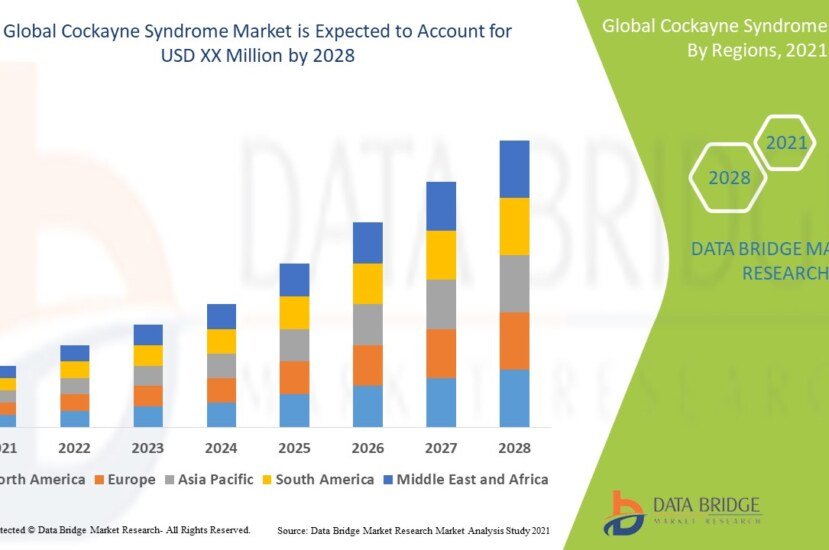Introduction
Cockayne Syndrome (CS) is a rare genetic disorder characterized by growth failure, premature aging, neurodegeneration, photosensitivity, and developmental delays. The disorder is caused by mutations in the ERCC6 (CSB) or ERCC8 (CSA) genes, which impair the body’s ability to repair DNA damage caused by ultraviolet (UV) light. Although the prevalence of Cockayne Syndrome is low, the severity of the disease and lack of a definitive cure have made it a focus of research and therapeutic development.
The Cockayne Syndrome market encompasses diagnostics, therapeutic interventions, supportive care, and research-driven treatments. Rising awareness of rare genetic disorders, advancements in gene therapy, targeted treatments, and genetic testing, and growing funding for rare disease research are driving interest in this market.
Source – https://www.databridgemarketresearch.com/reports/global-cockayne-syndrome-market
Market Overview
Market Size (2024): Estimated at USD 50–60 million
Forecast (2032): Expected to reach USD 120–130 million
CAGR (2025–2032): Around 8–9%
Growth in this market is fueled by advances in molecular diagnostics, research collaborations, and increasing government and private funding for rare disease treatments.
Key Market Drivers
Advancements in Genetic Testing:
Early diagnosis through whole-genome sequencing, exome sequencing, and targeted gene panels is crucial for patient management and clinical trial enrollment.
Rising Awareness of Rare Diseases:
Increased knowledge about CS among healthcare providers and patient advocacy groups has improved diagnosis rates and treatment accessibility.
Development of Targeted Therapeutics:
Research on gene therapy, RNA-based treatments, and small-molecule therapies offers potential disease-modifying options.
Government and Private Funding:
Rare disease initiatives, orphan drug incentives, and grants support the development of diagnostics and treatments for Cockayne Syndrome.
Supportive Care Growth:
With no definitive cure available, demand for nutritional support, physiotherapy, audiological care, and vision management is increasing.
Market Segmentation
By Therapeutic Type
Gene Therapy and Molecular Treatments: Experimental therapies targeting defective DNA repair pathways.
Symptomatic and Supportive Care: Nutritional supplements, physical therapy, audiology, and ophthalmology care.
Drug Development and Orphan Drugs: Focus on disease-modifying agents in preclinical and clinical trials.
By Diagnostic Type
Genetic Testing: DNA sequencing and mutation analysis for ERCC6 and ERCC8 genes.
Clinical Diagnosis: Assessment of phenotypic symptoms such as growth failure, neurological impairment, and photosensitivity.
By End User
Hospitals and Clinics: Primary points for diagnosis, treatment, and supportive care.
Research Institutions: Conduct studies on disease mechanisms, therapeutic development, and clinical trials.
Specialized Rare Disease Centers: Provide holistic care, including genetic counseling and long-term management.
By Region
North America: Dominates the market due to advanced healthcare infrastructure, rare disease awareness, and high research funding.
Europe: Growth supported by orphan drug incentives, rare disease networks, and clinical research initiatives.
Asia-Pacific: Emerging interest with increasing diagnostic capabilities and investment in genetic research.
Latin America & Middle East: Gradual market development driven by improved healthcare access and rare disease awareness.
Key Market Trends
Gene Therapy Research:
Advancements in CRISPR-Cas9, antisense oligonucleotides, and RNA-based therapies are opening new avenues for disease-modifying treatments.
Expansion of Genetic Testing:
Next-generation sequencing (NGS) and affordable genetic testing options are improving early detection and personalized care.
Patient Advocacy and Rare Disease Networks:
Organizations are increasing awareness, funding, and support for families affected by Cockayne Syndrome.
Collaborative Research Models:
Partnerships between biotech companies, academic institutions, and government agencies are accelerating therapeutic development.
Digital Health Integration:
Telemedicine and electronic health records facilitate remote monitoring, symptom tracking, and access to specialized care.
Challenges
Limited Patient Population: The rarity of Cockayne Syndrome makes large-scale clinical trials and commercial viability challenging.
High Research and Development Costs: Gene therapy and molecular treatment development require significant investment.
Lack of Curative Treatments: Current interventions are largely symptomatic, limiting long-term patient outcomes.
Regulatory Hurdles: Approval of orphan drugs and gene therapies requires compliance with stringent regulations.
Awareness and Accessibility: Many regions still lack specialized healthcare centers and diagnostic facilities.
Competitive Landscape
The Cockayne Syndrome market is niche but competitive, with key players focusing on diagnostics, orphan drug development, and gene therapy research. Major stakeholders include:
Biotech and Pharmaceutical Companies developing gene therapies and small-molecule treatments.
Specialized Diagnostics Providers offering genetic testing and clinical assays.
Research Institutions and Rare Disease Foundations conducting preclinical and clinical studies.
Collaborations and strategic partnerships are common to accelerate therapeutic development and market access.
Future Outlook
The Cockayne Syndrome market is expected to grow steadily due to:
Increasing adoption of genetic testing and early diagnosis.
Development of gene therapies and molecular interventions targeting underlying DNA repair defects.
Expansion of rare disease awareness, funding, and patient support networks.
Technological advances enabling personalized medicine and precision therapies.
As research progresses, the market is likely to see innovative disease-modifying therapies, improved patient care, and increased global collaboration.
Conclusion
The Cockayne Syndrome market represents a critical area within rare disease research and treatment. Driven by genetic testing advancements, gene therapy development, and growing awareness, the market offers opportunities for biotech companies, research institutions, and healthcare providers.
Future growth will depend on successful therapeutic development, early diagnosis, regulatory support, and expanded patient access, ultimately improving quality of life for those affected by this rare genetic disorder.




Leave a comment